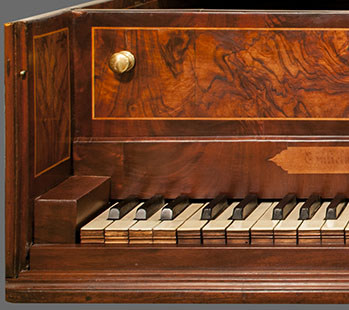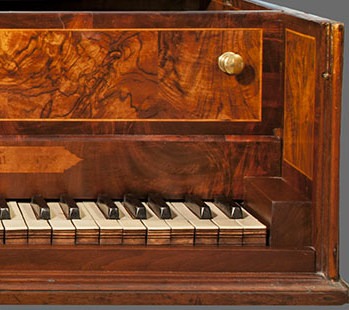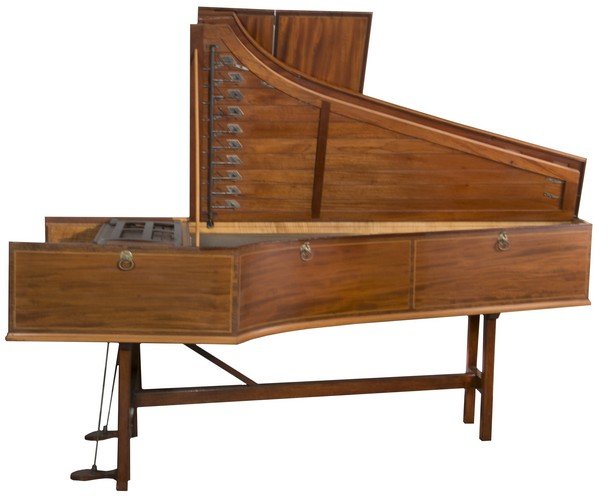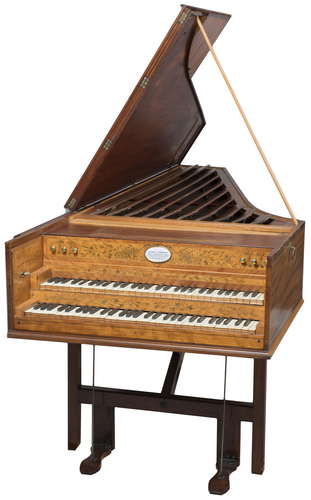
Early Keyboard Ventures
and related speculations by John Watson


Early Keyboard Ventures
and related speculations by John Watson



Photos by Jason Copes, The Colonial Williamsburg Foundation.
Subsequent conservation included removing the added diagonal brace from the stand and replacing the original casters.
George Washington's Mount Vernon (visit website)
(1) Make a thorough examination of the 1793 original producing comprehensive drawings and notes about its design and evidence of construction methods.
(2) Make a working replica of the instrument.
• Phase 1 (completed): Examination, documentation, and minor stabilization conservation of the original instrument. This was completed by August 2016
by John Watson in the Instruments Conservation Lab at The Colonial Williamsburg Foundation (CWF). The instrument went on temporary exhibit in CWF's
Dewitt Wallace Decorative Arts Museum on completion of that phase.
• Phase 2 (in progress): Reproduction of the harpsichord (see acknowledgements for project staffing). Work began in early 2017 and is scheduled to be completed by the end of 2018.
• Colonial Williamsburg Foundation for exhibiting the original harpsichord, assistance with analysis, and continuing cooperation with the replication process.
• The project was made possible with funding from the Life Guard Society of Historic Mount Vernon. Other donors include The Stella Boyle Smith Trust, The Brown Foundation, Inc.,
Deborah McManus, J.W. Pepper & Son, Inc., Dr. J. Phillip London and Dr. Jennifer Burkhart London, James and Pamela Penny, Rose M. Gunthorpe, and Heather Karen Hunt.
• Project Staff: John Watson, project conservator and principle harpsichord maker; Kevin Clancy, blacksmith; John (Jay) Gamble, fabrication assistant. Website design and
photography by John Watson except where noted. Additional photography by Jay Gamble and Linda Baumgarten.
• Mount Vernon staff, especially Dr. Susan Schoelwer, Senior Curator; Carol Cadou, Senior VP Historic Preservation & Collections; Jesse MacLeod, Associate Curator;
• Research collaborators: Joyce Lindorff, Steven Mallory, David Hildebrand.
• Special thanks to instrument makers Tom & Barbara Wolf for providing soundboard & pin block material & consulting.
In 1793, George Washington acquired a large harpsichord for his step grand-daughter, fourteen-year-old Eleanor Parke
Custis (“Nelly”) who he and Martha raised as their own. Nelly had already been provided a square piano and had received piano
lessons from the celebrated composer and performer Alexander Reinagle. Of the several musical instruments that graced Mount Vernon,
none was more grand or impressive than the imposing two-manual harpsichord.
The instrument had been ordered from Longman & Broderip, the largest firm of music merchants in London. It arrived at the executive mansion in Philadelphia around the midpoint of George Washington’s presidency and moved with the family when they returned to Mount Vernon.
The harpsichord is remarkable for its musical gadgetry, and shows the lingering importance of harpsichords during a time when the piano was rapidly ascending as the dominant stringed keyboard instrument. Washington’s harpsichord was eventually moved to Arlington House, the home of Nelly’s younger brother. His daughter, who inherited Arlington along with the harpsichord, married Robert E. Lee and eventually saw to the instrument’s return to Mount Vernon where it remained until its temporary loan for the Changing Keys exhibit at Colonial Williamsburg.
The instrument shows how sophisticated the largest harpsichords had become at the culmination of their eighteenth century heyday. Built at a time when the piano was already overtaking the harpsichord as the most popular stringed keyboard instrument, the Mount Vernon example’s many gadgets for changing the sound were efforts to keep up with changing tastes. Hand stops control three sets of strings (two at normal pitch and one an octave higher) and a pedal gives the ability to change several stops at once. A buff stop makes a softer sound as if plucking the strings of a guitar, while another stop plucks the strings very near the ends to create a more nasal tone. A second pedal operates a “Venetian swell.” Pressing it opens a set of louvers like Venetian blinds, enabling the player to crescendo or decrescendo; a feat more naturally achievable on a piano. Indeed, the desire to create variations of volume would find its full expression in the piano, and by the end of the 1790s, harpsichords would no longer be produced in any quantity until their popularity surged once again in the twentieth century.
While the original Mount Vernon harpsichord was entrusted to the Colonial Williamsburg Foundation (CWF) Department of Conservation, and in the final six weeks of my employment there, I examined the Mount Vernon harpsichord, disassembling it as much as reasonably possible without breaking glue seams. With valuable assistance from my conservation colleagues at CWF I identified materials, measured all components, and studied evidence of the original construction. Internal clues included pencil markings, scribe lines, tool marks, glue runs, and signs of wear and early use. While making the reproduction, I have made dozens of follow-up visits to the harpsichord to re-examine details as questions arise.
The jacks are the mechanical heart of the harpsichord. They hold the pieces of leather that pluck the strings, and of all the hundreds of parts in a harpsichord, they demand the highest level of precision and workmanship to work reliably. There are 244 jacks in the instrument, each consisting of only two main parts: a jack body of pearwood and a tongue of holly wood. There is also a hand-formed staple of tinned brass and a spring of boar's bristle. Each jack requires many steps to make.
The keyboards are the "user interface" for the musician. This harpsichord has two keyboards of the standard late eighteenth-century compass of five octaves FF-f3. The keys rest on a keyframe and are guided by tinned brass pins. The limewood for these key levers was imported from England. It is slightly denser than basswood, which is the more common wood used for keyboards in America. The original keyboard has ivory naturals, and we have substituted bone. The sharps are solid ebony.
The harpsichord's curved side is called the bentside. It is a hefty, 13 inch wide plank of 3/4-inch thick oak. The curved half was boiled for 45 minutes in a 55-gallon drum and bent over a shaped form and the bentside left to dry for a month. Photos and a video in this album show the process. Jay Gamble assisted during the preparation and bending process.
Various parts are made including—in this group—the tuning pin block, the music desk, and the trestle stand.
The cases of virtually all late eighteenth-century English harpsichords are made of solid oak, then covered with decorative and sometimes figured veneers. Here we cut dovetails into the oak sides, veneer any interior surfaces, and assemble the case with glue. Structural framing inside prepares the case to withstand thousands of pounds of string tension.